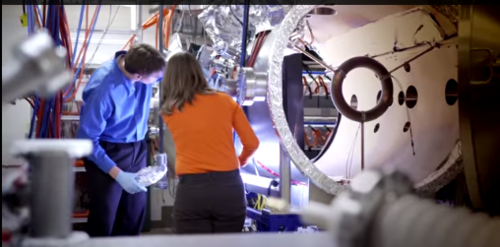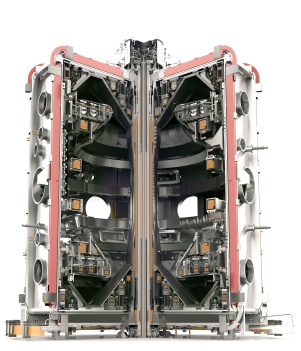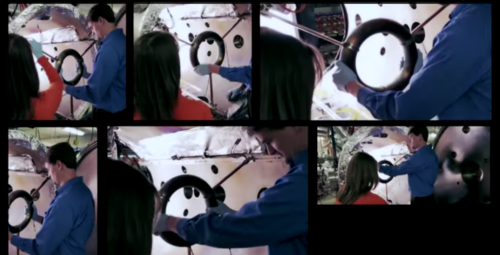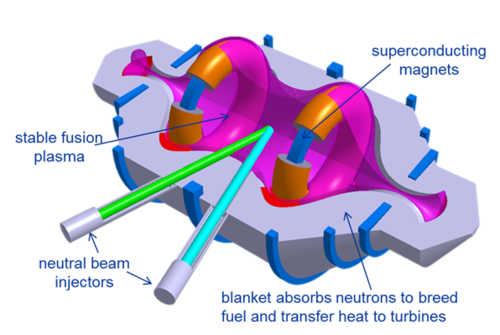There’s been a lot of buzz about a press release from Lockheed Martin about a fusion concept they’ve been working on. The press release says practically nothing, and the accompanying video says little more. What’s incredible is that this not even a news – Lockheed Martin have been working on this for years, and even presented a far longer video almost two years ago at the Google run event ‘Solve for X’.

Frame from the Lockheed Martin video showing a cylindrical vacuum vessel with a single coil supported by three posts.
A common narrative in technology these days is of radical new ideas that revolutionise the field. By playing into this narrative, companies can generate excitement for their product, and therefore revenue from their investors. In some fields, true innovation is easy to evaluate. AirBnB has the obvious advantage of running a hotel where you don’t pay tax or conform to local health and safety laws. The cost savings are obvious. In nuclear fusion, it’s quite hard to evaluate a proposal, and the real absence of information on Lockheed Martin’s proposal makes it even harder.
Despite this, they give some hints away – surprisingly, the video from Solve for X actually has more information, which does make you wonder what the team has been doing for the last two years.
The Lockheed Martin design is a ‘compact fusion reactor’ with the following features:
- Cylindrical vacuum vessel
- Small vessel
- High-Beta plasma
- RF heating
The trouble is, none of these ideas are new.

MAST at CCFE in the UK, a ‘spherical tokomak’ with a cylindrical vacuum vessel.
MAST in the UK has used a cylindrical vacuum vessel for ages. Cylinders are easier to make than toroids, but unless you have a cylindrical plasma, they are not more compact that vacuum vessels made to fit, like that on NSTX in the US.
Having a small vessel is neat in that you have a compact reactor, but it makes it very hard to keep your plasma confined. To keep the plasma hot, you have to stop the particles in the plasma from hitting the walls of your vessel. The simplest way to do this is to put the walls far away, and have a big plasma inside a big vessel. In fact, the time it takes for a particle to randomly walk out of the plasma increases with the square of the size of the vessel, so a vessel that’s twice as wide will hold particle for four times as long. Big is better when using magnetic confinement.
‘High-Beta’. This comes up a lot, and:

‘Beta’ is a measure of how much pressure you can exert on the plasma externally compared to how much pressure the plasma exerts on itself. Ideally, the plasma would do all the work, but in reality hot, dense blobs of thermonuclear matter tend not to be very stable and we opt to carefully control the plasma by other means.
One way to think about plasma beta is to think about the plasma as a raging river, and the magnetic field as the banks of the river that stop it from flooding out. A low beta machine has very high banks (large magnetic pressure) compare to the height of the water (the plasma pressure). Even though the water doesn’t have a smooth surface (it has ripples and torrents and waves) the walls are high enough to contain these ‘disruptions’. But high walls are expensive to build, so it’s tempting to try to get away with worse flood defences.

Thinking about plasma beta like the walls used to hold back raging rivers, here seen in cross section. The numbers are the ratio of the wall height to the river height, which in this analogy is the ratio of the plasma pressure to the magnetic pressure.
What Lockheed Martin call ‘high beta’ means that they’ve lowered the flood defenses so the height of the banks is almost the same as the height of the water. This is more economical because, just like big walls, big magnets are expensive to build. But it offers no protection against a sudden surge of water which could easily flood over the walls. In a fusion reactor, this would correspond to a sudden surge in plasma pressure, which could break through the magnetic pressure and allow the plasma to escape the machine. When TFTR, one of the largest fusion devices ever built, was first being used, a disruption caused the entire reactor to lift half a metre off the floor and then slam back down. The reactor weighed 40 tonnes. That’s a lot of force.
True high beta is when the walls are actually lower than the water. This is an obviously unstable situation, but in these reactors the idea is to quickly get the energy out of the plasma before the plasma floods out of the device. I wrote a post about the difference between the low beta and the true high beta approaches if you want to read more.
Finally, Lockheed Martin claim to use ‘RF heating’, short for radio frequency heating. This amounts to microwaving your plasma to heat it up. It’s a tried and tested technique, but it’s hardly new. It’s possible the coil suspended in the machine is for RF heating, though more likely it’s to provide a magnetic field.

Frame from the recent Lockheed Martin video showing off multiple views of the ‘coil’. We don’t know what it does, but they look very excited about it, possibly because it’s the only thing inside their vacuum vessel to look at.
I can’t see any diagnostics attached to the machine in the recent Lockheed Martin video. It’s hard to say how they will be able to work out how hot their plasma is, how dense it is, and how well the plasma is confined. And that really points to the bigger problem with this press release – it doesn’t look like science. There are very few details, no numbers, no schematics or clear photographs, not even a hand-wavy explanation. Lockheed Martin make this look like a publicity stunt, and it has worked extremely well for them judging by the coverage across the internet. And that’s disappointing, because I suspect this project won’t work, and it will be quietly killed off, and we’ll never know what they tried and what worked and what failed. Then in twenty years time someone else will probably try it and fail again, because they can’t know that this idea has already been tested.
I agree with a lot of the stuff Lockheed Martin put in their video. Fusion is exciting and essential. It’s a clean source of energy that could be a boon to the developing and developed world (though as Lockheed Martin are the world’s largest arms manufacturer I feel their altruism might be slightly tainted). But the way they’ve released this information doesn’t make me optimistic that they will be able to build a fusion reactor, and that’s disappointing.
***UPDATE***
It turns out that some news outlets received more material than was in the press release and video. This image alone explains a lot:

It looks like that lonely coil in the video is meant to have a buddy (or three or four in other photos), and the coils are superconducting. This should mean the magnetic field can push back harder if the plasma pushes against it, something which again isn’t new, but is interesting.
The trouble is that superconductors are very temperamental – they have to be kept extremely cold. A big problem inside fusion reactors is neutron shielding. Neutrons are uncharged particles produced by the fusion reaction, and they have a lot of kinetic energy. Because they are uncharged they can travel a long way through materials and deposit their energy deep inside, say, a superconducting magnet. If this happened, and the temperature of the superconductor went above a critical value, the ring would become a normal conductor, at which point the unlucky coil would quickly melt. Not fun.
A huge amount of effort goes into designing neutron shielding in fusion reactors, and this shielding is the reason that these reactors are so large an expensive. There is no known material that has the neutron stopping power necessary to build the small scale device Lockheed Martin are proposing.
The other problem is at the ends of the device, where the plasma (in purple) reaches the walls. The magnetic field lines intersect the wall here, so any particle following a field line will collide with the wall and cool right down. This means fuel has to be constantly pumped in to replace the fuel that’s lost, and the plasma has to be aggressively heated. This is presumably what the neutral beam injectors are for. Even worse is that this device focuses a jet of hot charged particles at a small spot on the vacuum vessel wall – a sure recipe for a neat little hole drilled out of the vessel.
Finally, labelling your plasma ‘stable fusion plasma’ does not make it so, and the fact they are sticking close to beta =1 means a whole host of instabilities could shred this plasma quickly.